This article was medically reviewed by Janice Litza, MD. Dr. Litza is a board certified Family Medicine Physician in Wisconsin. She is a practicing Physician and taught as a Clinical Professor for 13 years, after receiving her MD from the University of Wisconsin-Madison School of Medicine and Public Health in 1998.
There are 22 references cited in this article, which can be found at the bottom of the page.
wikiHow marks an article as reader-approved once it receives enough positive feedback. In this case, 100% of readers who voted found the article helpful, earning it our reader-approved status.
This article has been viewed 584,996 times.
Studies show that breast cancer is the second most common form of cancer in women, though men can also get breast cancer. Although breast cancer is so common, you're likely really scared if you've noticed changes in your breasts or have a family history of breast cancer. Experts say symptoms of breast cancer can be different for each person, but common symptoms include a lump, thickening or swelling in your breast, breast pain, unusual discharge, and skin changes around your breast.[1] Talk to your doctor if you think you might have breast cancer because early detection may increase your chances of successful treatment.
Steps
Increasing Breast Awareness
-
1Understand the changing research on the usefulness of breast self-examination. In the past, a monthly breast self-examination (BSE) was recommended for all women. However, in 2009 after the publication of several large studies, the US Preventative Services Task Force recommended against teaching women to do consistent and formal self-examinations.[2] These research studies concluded that BSE didn't reduce mortality or increase the number of cancers found.[3]
- Recommendations by the American Cancer Society and the US Preventative Services Task Force state that BSE should be done at the discretion of women and that they be informed of the limitations of BSE. Perhaps most importantly, these organization stress how important it is that women be aware of what is normal for their breast tissue.
- In other words, a BSE does and should not take the place of a physician's examination for detecting abnormalities. However, doing a BSE can help you become more aware of what is normal in your breasts and can help you assist your doctor in detecting changes. BSE should never be seen as a way to replace a clinic breast exam done by a physician.[4]
-
2Do a visual BSE. You can do this whenever you like, although it's a good idea to do it after your period, when your breasts are less tender and swollen. Try to do it every month at around the same time. In front of a mirror, sit or stand without a shirt or bra on. Lift and lower your arms. Look for any changes to the size, shape, tenderness, and appearance of your breast tissue, and the area surrounding, especially your underarm or armpit area. These changes may include:[5]
- Dimpled and puckered skin, like the skin of an orange (known as peau d’orange).
- New redness, or a scaly rash.
- Unusual breast swelling or tenderness.
- Nipple changes, such as retraction, itchiness, or redness.
- Nipple discharge, which can be bloody, clear or yellow.
Advertisement -
3Do a manual BSE. The ideal time to do a BSE if you are still menstruating is when your breasts are the least tender, so usually a few days after your period ends. You can do the examination either lying down, where the breast tissue is more spread out and thus thinner and easier to feel, or in the shower, where the soap and water can help your fingers move more smoothly over your breast skin. Follow these steps:[6]
- Lie flat and place your right hand behind your head. Using the first three fingers of your left hand palpate (feel) the breast tissue on your right breast. Be sure to use the pads of the fingers, not just the very tips.
- Use three different levels of pressure to feel the tissue at the top under the skin, in the middle of the breast and deeper pressure to feel the tissue close to the chest wall. Make sure to apply each pressure level to each area before moving on.
- Start at an imaginary line drawn down your side from your underarm and move in an up and down pattern. Start at the collar bone and move downward until you reach your ribs. Move across to the middle of your body until you only feel the sternum (breastbone). It's important to examine the whole breast so try to be a bit methodical in your BSE.
- Then, reverse this process and put your left hand under your head and perform the same exam on your left breast.
- Remember that your breast tissue extends to the area near your armpit. This area of the breast is often called the tail and can also develop lumps or cancer.
-
4Get comfortable with your breasts. Know how they look and feel. Establish a familiarity with them and their texture, contours, size, etc. You’ll be better able to communicate changes with your physician.
- Advise your partner to communicate any changes they may notice. Your partner may notice differences in your breast tissue that you may have overlooked since they can see your body from a different angle
-
5Know your risk factors. Some people have a higher chance of developing breast cancer than others. Be aware, though, that just because you may fall into one or more of these categories, you’re not doomed to have breast cancer; however, it does mean that you should be more aware about your breasts and get regular clinical breast exams and mammograms. Some factors that indicate higher risk include:[7]
- Gender: Women are more likely to develop breast cancer than men.
- Age: Risk increase with age. Most people who have breast cancer are over 45 years old.
- Menstruation: If you started menstruating before you were 12 years old, or entered menopause when you were older than 55, your risk is slightly increased.
- Pregnancy and breastfeeding: An early pregnancy or multiple pregnancies can both reduce your risk, as does breastfeeding. Having no children or getting pregnant after the age of 30 increases your risk of developing breast cancer.
- Lifestyle factors: Obesity, smoking and alcohol use are all risk factors for breast cancer.
- Hormone replacement therapy (HRT): Current or previous use may increase the risk for breast cancer. However, this is still being debated with studies coming out regularly for and against, so it's best to have an open discussion with your doctor about personal risks, other options, and monitoring.
-
6Know your personal and family medical history. There are also risk factors related specifically to you, your family history, and your genetics, including:[8]
- Personal medical history: If you have had a previous diagnosis of breast cancer, there is a risk that the cancer can re-occur in the same or opposite breast.
- Family history: You are more likely to develop breast cancer if one or more members of your family have had breast, ovarian, uterine or colon cancer. Your risk is doubled if you have a first-degree relative (sister, mother, daughter) with the disease.
- Genes: Genetic defects found on BRCA1 and BRCA 2 can dramatically increase your risk of developing breast cancer. You can opt to find out if you have these genes by contacting a genome mapping service. In general, approximately 5-10% of cases are related to heredity.
Recognizing Specific Symptoms
-
1Watch for changes in breast size or shape. Swelling from a tumor or infection can distort the shape and size of the breast tissue. This change often occurs on only one breast, but may appear to be on both sides.[9]
-
2Note any unusual discharge from the nipple. If you are not currently breastfeeding, there should be no discharge coming from the nipple. If there is discharge, especially without squeezing the nipple or breast tissue, seek medical attention for further testing.[10]
-
3Look for swelling. In particular, look for swelling around the breast, collarbone or armpit. There are aggressive and invasive types of breast cancer that may cause swelling in these areas before you can feel a lump in the breast tissue.[11]
-
4Observe for a dimpling in the breast tissue or changes in the nipple. Tumors or growths in the breast near the surface of the skin or nipple can cause a change in shape of the tissue.[12]
- In some instances, the nipple will become inverted or you may notice a dimpling in the skin over the breast tissue.
-
5Report skin thickening, redness, warmth or itching. Inflammatory breast cancer, though rare, is a particularly invasive and aggressive type of cancer. It may present with symptoms similar to an infection in the breast, such a tissue that is warm, itching or red. If antibiotics do not quickly resolve the issue you should seek the care of a breast surgeon immediately.[13]
-
6Be aware that pain is not normal. If you experience pain in your breast tissue or at the nipple area which does not resolve quickly you should seek medical attention. Breast tissue is not normally painful and pain may indicate an infection, growth, or lump or tumor. However, breast pain is not usually a sign of cancer.[14]
- Keep in mind that if you are still menstruating or pregnant, you may experience temporary breast soreness, discomfort, tenderness as a result of hormone fluctuations. However, if you feel pain and it is persistent and unrelated to your menstrual cycle, you should still consult your doctor.[15]
-
7Recognize signs of advanced breast cancer. Remember, exhibiting these signs doesn’t necessarily mean you have breast cancer. They’re all good reasons to see a doctor, though, for further investigation. Such symptoms include:[16]
- Weight loss.
- Bone pain.
- Shortness of breath.
- Ulceration of the breast, meaning the existence of sores that may be red, itchy, painful and ooze pus or clear fluid.
Undergoing Medical Screening for Breast Cancer
-
1Get a clinical breast exam. When you go in for your yearly physical or pelvic exam, ask your physician to do a manual check of your breasts for any suspicious lumps or other changes. Physicians are trained in how to do a breast exam and will know what to look for. This is why you should never try to replace this exam, though sometimes uncomfortable and awkward, with your own self-examination.[17]
- Your doctor will begin by checking the appearance of your breasts. You will be asked to raise your arms over your head and then hang them down by your sides while the doctor examines the size and shape of your breasts. You will then undergo a physical examination. While you lie down on the examination table, your doctor will use the pads of their fingers to examine the entire breast area, including the armpits and collarbones. The exam should last for only for a few minutes.[18]
- If you feel uncomfortable, you can ask for a nurse or family member to be present in the room for the exam. If you’re a female patient seeing a male doctor, this is standard procedure in most cases. If you feel any anxiety, take a deep breath and remind yourself that this is a necessary part of keeping an eye on your health.
-
2Get a screening mammogram. A mammogram is a low-radiation X-ray used to examine breast tissue, and it can often detect lumps before you’re able to feel them. The National Breast Cancer Foundation recommends a screening mammogram every one to two years for women 40 and older. Women who are younger than 40 but who have risk factors for breast cancer should consult with their physician about how often to have mammograms. Even if you have no known risk factors or symptoms, regular mammograms every few years as part of your physical is recommended.[19]
- In the mammogram, your breast is placed on a platform and compressed with a paddle to even out the breast tissue, hold the tissue still during the x-ray, and allow for the use of a lower-energy x-ray. You’ll feel pressure and may experience some discomfort, but this is just temporary. The will be done on both breasts so the radiologist can compare both sides.
- Although the doctor may be looking for potential cancerous growth with a mammogram, the test can also detect calcifications, fibroadenomas and cysts.[20]
-
3Get additional testing if any lumps or other suspicious changes are noticed. If you or your physician notice a lump or anything else that raises alarm bells, such as nipple discharge or skin puckering, you may need to undergo additional testing to determine the cause and whether or not you have breast cancer. These tests may include:[21]
- Diagnostic mammogram: A breast X-ray to evaluate the lump. This may take longer than a screening mammogram because more images will be required.
- Ultrasound: Ultrasonic waves are used to produce an image of the breast. Current evidence reports this test is best used in conjunction with a mammogram. Although non-invasive and simple, the ultrasound will have many false positive and false negative results. However, this imaging study is often used with great results to guide a needle biopsy of a suspected tumor.[22]
- Magnetic resonance imaging (MRI): This test uses magnetic fields to create images of the breast. You may undergo an MRI if the diagnostic mammogram does not rule out a tumor or growth. This imaging technique is also commonly recommended for women who are at very high risk of developing breast cancer, such as those women with a family history or genetic disposition.[23]
-
4Get a biopsy. If the mammogram and MRI detect a tumor or growth, your physician may recommend an ultrasound-guided needle biopsy to determine both the type of cell growth and the surgical procedure or chemotherapy treatment necessary to treat the cancer. In a biopsy, a very small piece of tissue is removed from the suspicious area of the breast and analyzed. This procedure is usually done with a larger needle through numbed skin. Most breast tissue biopsies are outpatient procedures, and you won’t have to stay overnight in a hospital. Only in the case of a surgical biopsy (also known as a lumpectomy) will you be put under local anesthesia.[24]
- Tissue biopsy is necessary before treatment options are decided in order to determine the nature of the cancer. Though a biopsy may seem and is indeed scary, it is important to know whether the cells in the breast tissue are cancerous and then to decide on a course of treatment. The earlier breast cancer is caught, the greater the survival rate.
- It's important (and encouraging!) to note that 80% of women have a breast biopsy do NOT have breast cancer.[25]
-
5Wait for results. Waiting for the results of biopsies and scans can be a stressful and anxious time. People cope in different ways. Some like to distract themselves with fun activities and keep busy. Others find it useful to read up on breast cancer and try to learn about all of the options available if the diagnosis is positive. Some people also use the waiting time to reflect on their lives and (re)assess their priorities and relationships.[26]
- Get plenty of exercise and eat healthily in order to keep your energy and spirits up. Seek social support from friends, colleagues or family members who have experienced similar situations and who may be able to offer insight and suggestions for effective coping.
- If you find yourself obsessing, feeling overwhelmed, or depressed to the point that your mental and physical well-being is at risk, you should let your health provider know. It can be useful to get in touch with a mental health professional or counselor to talk about what you're feeling as you wait for diagnosis.
Expert Q&A
-
QuestionI have a discharge coming from my breasts. It looks yellowish, but it only comes out if I apply pressure. Should I go see a doctor about it?
 Janice Litza, MDDr. Litza is a board certified Family Medicine Physician in Wisconsin. She is a practicing Physician and taught as a Clinical Professor for 13 years, after receiving her MD from the University of Wisconsin-Madison School of Medicine and Public Health in 1998.
Janice Litza, MDDr. Litza is a board certified Family Medicine Physician in Wisconsin. She is a practicing Physician and taught as a Clinical Professor for 13 years, after receiving her MD from the University of Wisconsin-Madison School of Medicine and Public Health in 1998.
Board Certified Family Medicine Physician There are many other causes for nipple discharge that are not cancer and you should see your doctor for full evaluation including pregnancy or breastfeeding status, medication or herbal supplement changes, and hormone changes.
There are many other causes for nipple discharge that are not cancer and you should see your doctor for full evaluation including pregnancy or breastfeeding status, medication or herbal supplement changes, and hormone changes.
Warnings
- See your physician for a diagnosis. You cannot diagnose breast cancer at home. So before you get too worried or concerned, get the answers you need to make the right decisions.⧼thumbs_response⧽
- If you are not satisfied with the answers you are getting from your doctor, get a second opinion. This is your body and your life. It is good practice to listen to your inner voice about your health and get another opinion on the matter.⧼thumbs_response⧽
References
- ↑ https://www.cdc.gov/cancer/breast/basic_info/symptoms.htm
- ↑ http://www.uspreventiveservicestaskforce.org/Page/Topic/recommendation-summary/breast-cancer-screening
- ↑ https://www.cdc.gov/cancer/breast/basic_info/screening.htm
- ↑ https://medlineplus.gov/ency/article/001993.htm
- ↑ https://www.breastcancer.org/screening-testing/breast-self-exam-bse
- ↑ https://www.breastcancer.org/screening-testing/breast-self-exam-bse
- ↑ http://www.cancer.org/cancer/breastcancer/detailedguide/breast-cancer-risk-factors
- ↑ https://www.cancer.org/cancer/breast-cancer/risk-and-prevention/breast-cancer-risk-factors-you-cannot-change.html
- ↑ https://www.cdc.gov/cancer/breast/basic_info/symptoms.htm
- ↑ https://www.nhs.uk/conditions/breast-cancer/symptoms/
- ↑ https://www.cancer.org/cancer/breast-cancer/screening-tests-and-early-detection/breast-cancer-signs-and-symptoms.html
- ↑ https://www.cancer.org/cancer/breast-cancer/screening-tests-and-early-detection/breast-cancer-signs-and-symptoms.html
- ↑ https://www.cancer.org/cancer/breast-cancer/screening-tests-and-early-detection/breast-cancer-signs-and-symptoms.html
- ↑ http://www.nationalbreastcancer.org/breast-pain
- ↑ https://my.clevelandclinic.org/health/diseases/15469-breast-pain-mastalgia
- ↑ https://my.clevelandclinic.org/health/diseases/21497-metastatic-breast-cancer
- ↑ https://www.uofmhealth.org/health-library/tv7408
- ↑ https://www.uofmhealth.org/health-library/tv7408#tv7412
- ↑ https://www.cancer.org/cancer/breast-cancer/screening-tests-and-early-detection/mammograms/mammogram-basics.html
- ↑ https://www.breastcancer.org/screening-testing/mammograms/what-mammograms-show
- ↑ https://www.cancer.org/cancer/breast-cancer/screening-tests-and-early-detection.html
- ↑ https://www.cancer.org/cancer/breast-cancer/screening-tests-and-early-detection/breast-ultrasound.html
- ↑ https://www.cancer.org/cancer/breast-cancer/screening-tests-and-early-detection/breast-mri-scans.html
- ↑ https://www.cancer.org/cancer/breast-cancer/screening-tests-and-early-detection/breast-biopsy.html
- ↑ http://www.nationalbreastcancer.org/breast-cancer-biopsy
- ↑ http://www.nationalbreastcancer.org/breast-cancer-results
About This Article
The only way to be absolutely sure whether you have breast cancer is to visit your doctor yearly for a clinical breast exam. Between doctor’s visits, you can perform monthly self-exams to see if you can detect any changes to your breasts, but this is not a substitute for annual exams from your doctor. To perform a self-check, lie flat and place your right hand behind your head, then use the first 3 fingers of your left hand to feel the tissue on your right breast, feeling for any lumps, dents, or other abnormalities which weren’t there before. Switch hands and repeat for your left breast. Keep reading for advice from our medical reviewer about the factors that increase your risk of breast cancer, like your age and gender.
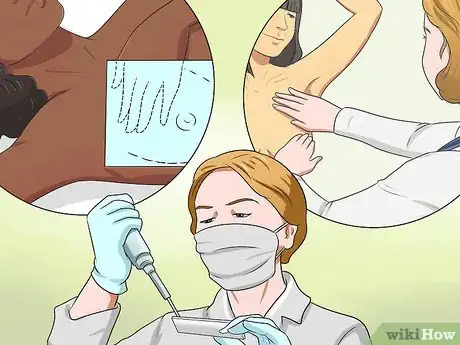

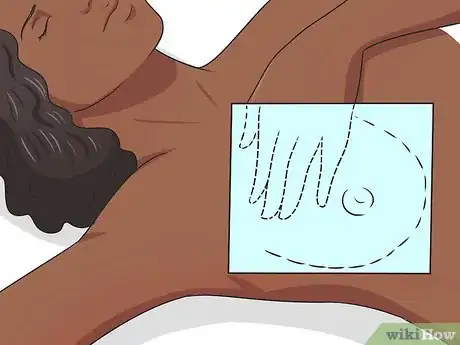
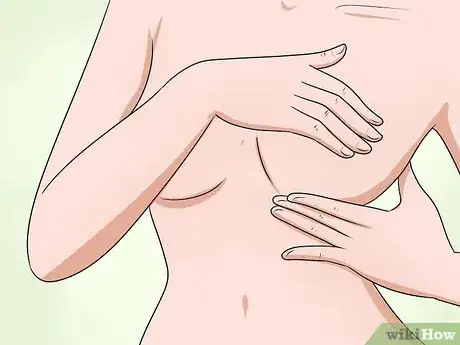



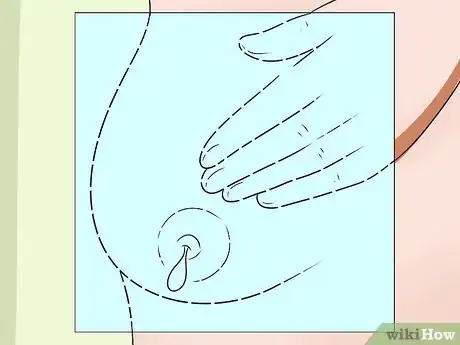

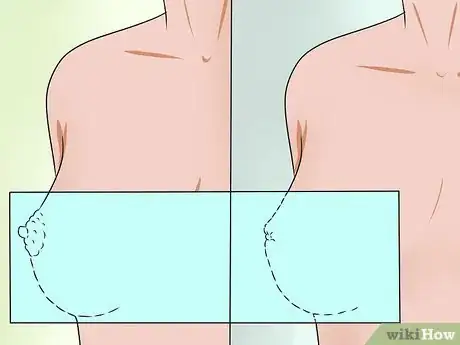
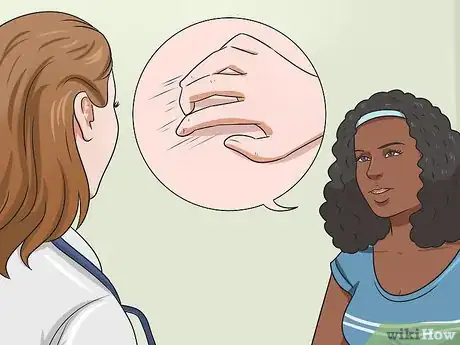
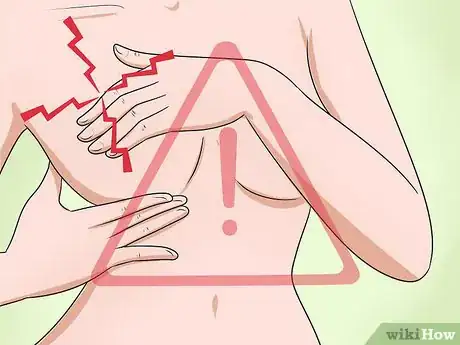
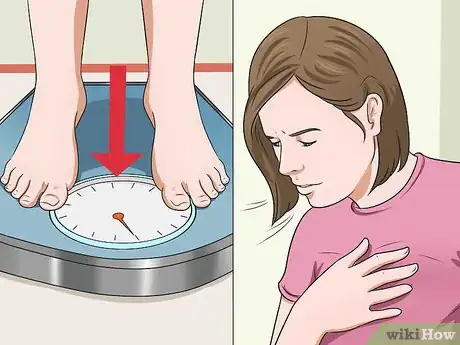
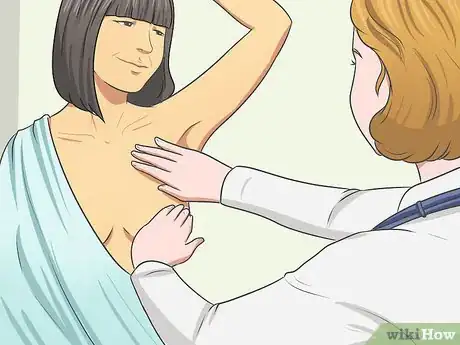

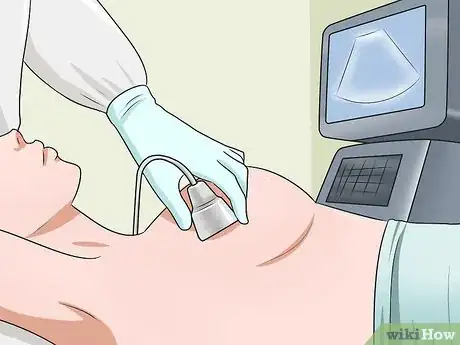
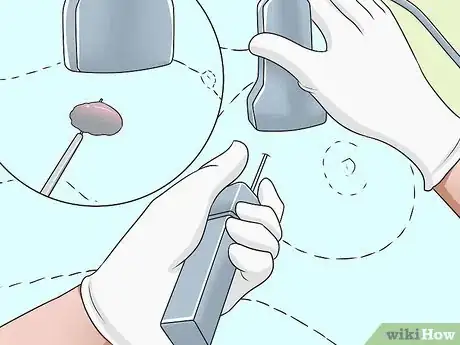








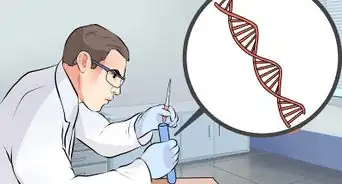

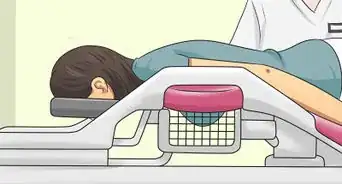

















































Medical Disclaimer
The content of this article is not intended to be a substitute for professional medical advice, examination, diagnosis, or treatment. You should always contact your doctor or other qualified healthcare professional before starting, changing, or stopping any kind of health treatment.
Read More...